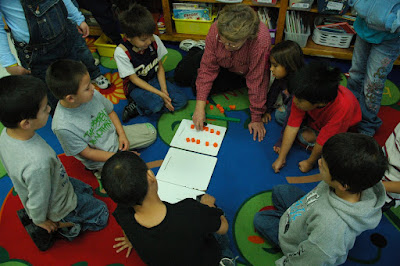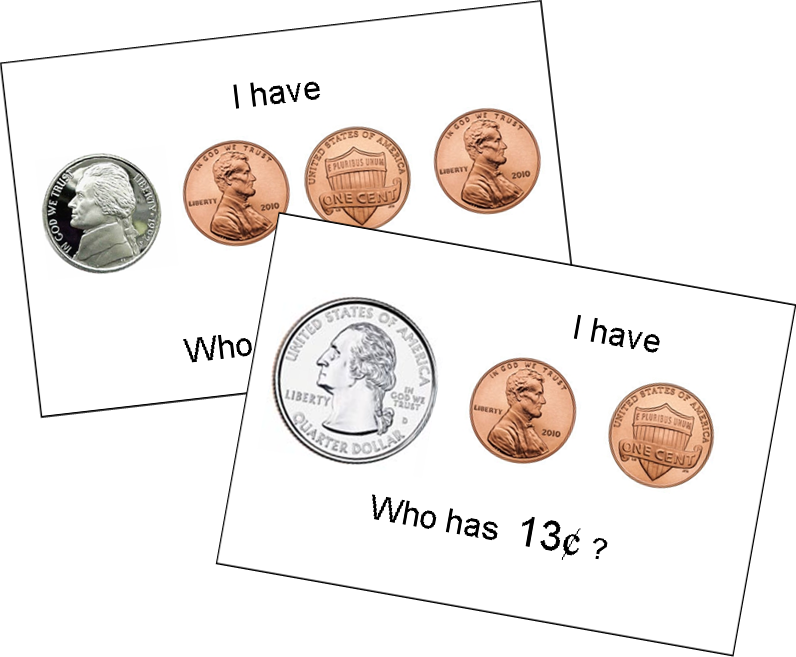Using the AMC software to chronicle your children's thinking is only the first step toward understanding their thinking so that you can provide activities to push them toward a deeper connection with number and quantity.
The next sensible step is to examine the data. Log into amcanywhere.com and look for the "Reports" icon.
From here, you'll be treated to a bevy of options!
The student detail report is extremely handy in getting to the nitty gritty details of an individual student's thinking. This is also a dynamite report for conferring with parents and colleagues about a particular student performance.
Any notes and comments you provide during their assessment will also appear on this report.
Wednesday, September 22, 2010
How Many?
For every young child, learning to count while simultaneously developing a sense of quantity is challenging work! Our data hints at the complexity hidden within the seemingly simple task of counting cubes.
 |
| 1st Grade Students Who Can Accurately and Consistently Count a Group of 21 Objects |
 |
| 1st Grade Students Who Can Accurately and Consistently Make a Pile of 18 Objects |
Why the discrepancy?
Counting is more than saying a rote sequence and recognizing a numeral. According to Kathy Richardson, "Counting is finding out how many."
Sunday, September 19, 2010
I Have... Who Has? Coin Cards!
The Mathwire has an excellent adaptation of the "I Have Who Has" activity using coin cards. Not only will this activity provide plenty of practice in using coin equivalence and coin recognition, but it will also give students some authentic practice in adding small quantities.
Download your own set of coin cards, and read all about the activity here at the Mathwire.
Friday, September 17, 2010
Non Linguistically Speaking
When students struggle to interpret story problems into a mathematical statement they can tackle and solve, a nonlinguistic representation may lead to success. Explicitly engaging students in the creation of lonlinquistic representations increases activity in the brain (Gerlic & Jausovec, 1999)
Language challenged 3rd graders might find this problem difficult to navigate:
Riverside School had 517 students last year. This year, 60 students moved away before school started. How many students does the school have now?
A nonlinguistic representation to help students create a mental picture of, and organize, the essential information.
Substituting the information from the problem, our representation becomes:
Using this representation, it is perhaps clearer to students that they are looking for the difference between 60 and 517. They could then solve the problem in one of two ways: by counting on from 60, or by subtracting 60 from 517.
Language challenged 3rd graders might find this problem difficult to navigate:
Riverside School had 517 students last year. This year, 60 students moved away before school started. How many students does the school have now?
A nonlinguistic representation to help students create a mental picture of, and organize, the essential information.
| TOTAL | |
| Part | Part |
Substituting the information from the problem, our representation becomes:
| 517 students (Total) | |
| 60 students (Part) | Part |
Using this representation, it is perhaps clearer to students that they are looking for the difference between 60 and 517. They could then solve the problem in one of two ways: by counting on from 60, or by subtracting 60 from 517.
Calculation Nation!
Calculation Nation® uses the power of the Web to let students challenge opponents from anywhere in the world. At the same time, students are able to challenge themselves by investigating significant mathematical content and practicing fundamental skills. The element of competition adds an extra layer of excitement.
“The games on Calculation Nation® provide an entertaining environment where students can explore rich mathematics,” said Jim Rubillo, Executive Director of the National Council of Teachers of Mathematics (NCTM). “Through these games, students are exposed to the same mathematical topics that they see in class as well as those that are recommended in Curriculum Focal Points.”
Thursday, September 9, 2010
The Motorcycle Boy Rules!
Velodrome: A velodrome is an arena for track cycling. Modern velodromes feature steeply banked oval tracks, consisting of two 180-degree circular bends connected by two straights. The straights transition to the circular turn through a moderate easement curve.
I hope that's enough math to justify another motorcycle post. Actually... who cares. The motorcycle boy rules!
What Do Third Graders Know About Addition?
Mr. Birch's third graders have been putting together a list of statements they believe to be true about addition. Here is what they have so far:
What do other third graders think about this list? If you'd care to add something, or have any questions for us, please leave a comment!

I have a question about the first item on their list. Mr. Birch's students suggest that numbers usually get larger with addition. Can you give an example of when the sum gets smaller???
What do we know about addition?
1. Numbers usually get larger.
2. You are putting things together.
3. Adding sign is +
4. Find the total.
5. How many all together?
6. What is the sum?
7. Addends can be added up in any order to the sum.
8. 7 ----addend ------ 5
+5 --- addend ------- + 7
12 ---- sum ------- 12
What do other third graders think about this list? If you'd care to add something, or have any questions for us, please leave a comment!

I have a question about the first item on their list. Mr. Birch's students suggest that numbers usually get larger with addition. Can you give an example of when the sum gets smaller???
Spring Creek Mathematicians Tell Addition Stories!
8 Sleeping Billy Goats + 2 Billy Goats Playing from (Chris) on Vimeo.
Mathematics is about far more than numbers - and certainly must include more than lists of rules. In her book What's Math Got to Do With It?, Jo Boaler describes math as
a human activity, a social phenomenon, a set of methods used to help illuminate the worldSecond graders at Spring Creek are exploring how mathematics can be used to illustrate simple stories. More specifically, they are crafting stories involving combinations of 10. Perhaps you can tell what time of day these were recorded by all the references to sleep. /grin
Monday, September 6, 2010
Motorcycles, Math, and Mistakes
First Start from (Chris) on Vimeo.
Some might think that the only math in the minds of bikers heading to Sturgis revolves around miles per hour and motel rates. When things go wrong, though mathematics is often the culprit. And just as reliably - part of the solution.
Two weeks ago, my engine stuck a valve. When I lifted the rocker covers, I found enough evidence to warrant a complete top-end overhaul. There was plenty of good math involved!
Subscribe to:
Posts (Atom)





